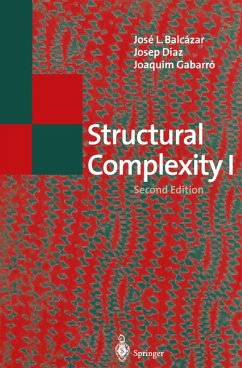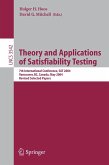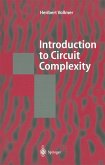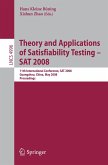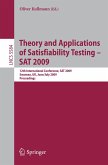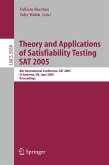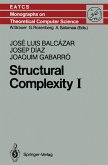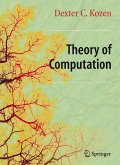40,95 €
40,95 €
inkl. MwSt.
Sofort per Download lieferbar

20 °P sammeln
40,95 €
Als Download kaufen

40,95 €
inkl. MwSt.
Sofort per Download lieferbar

20 °P sammeln
Jetzt verschenken
Alle Infos zum eBook verschenken
40,95 €
inkl. MwSt.
Sofort per Download lieferbar
Alle Infos zum eBook verschenken

20 °P sammeln
- Format: PDF
- Merkliste
- Auf die Merkliste
- Bewerten Bewerten
- Teilen
- Produkt teilen
- Produkterinnerung
- Produkterinnerung

Bitte loggen Sie sich zunächst in Ihr Kundenkonto ein oder registrieren Sie sich bei
bücher.de, um das eBook-Abo tolino select nutzen zu können.
Hier können Sie sich einloggen
Hier können Sie sich einloggen
Sie sind bereits eingeloggt. Klicken Sie auf 2. tolino select Abo, um fortzufahren.

Bitte loggen Sie sich zunächst in Ihr Kundenkonto ein oder registrieren Sie sich bei bücher.de, um das eBook-Abo tolino select nutzen zu können.
This first of the two-volume presentation of structural complexity introduces the background necessary for the understanding of complexity theory. It is written for undergraduate students with basic knowledge in Formal Language Theory and contains about 140 exercises and many bibliographical remarks. This second, corrected edition includes an appendix with recent results and an update of the references.
- Geräte: PC
- ohne Kopierschutz
- eBook Hilfe
- Größe: 51.54MB
Andere Kunden interessierten sich auch für
![Theory and Applications of Satisfiability Testing (eBook, PDF) Theory and Applications of Satisfiability Testing (eBook, PDF)]() Theory and Applications of Satisfiability Testing (eBook, PDF)40,95 €
Theory and Applications of Satisfiability Testing (eBook, PDF)40,95 €![Introduction to Circuit Complexity (eBook, PDF) Introduction to Circuit Complexity (eBook, PDF)]() Heribert VollmerIntroduction to Circuit Complexity (eBook, PDF)60,95 €
Heribert VollmerIntroduction to Circuit Complexity (eBook, PDF)60,95 €![Theory and Applications of Satisfiability Testing - SAT 2008 (eBook, PDF) Theory and Applications of Satisfiability Testing - SAT 2008 (eBook, PDF)]() Theory and Applications of Satisfiability Testing - SAT 2008 (eBook, PDF)40,95 €
Theory and Applications of Satisfiability Testing - SAT 2008 (eBook, PDF)40,95 €![Theory and Applications of Satisfiability Testing - SAT 2009 (eBook, PDF) Theory and Applications of Satisfiability Testing - SAT 2009 (eBook, PDF)]() Theory and Applications of Satisfiability Testing - SAT 2009 (eBook, PDF)40,95 €
Theory and Applications of Satisfiability Testing - SAT 2009 (eBook, PDF)40,95 €![Theory and Applications of Satisfiability Testing (eBook, PDF) Theory and Applications of Satisfiability Testing (eBook, PDF)]() Theory and Applications of Satisfiability Testing (eBook, PDF)40,95 €
Theory and Applications of Satisfiability Testing (eBook, PDF)40,95 €![Structural Complexity I (eBook, PDF) Structural Complexity I (eBook, PDF)]() Jose L. BalcazarStructural Complexity I (eBook, PDF)62,95 €
Jose L. BalcazarStructural Complexity I (eBook, PDF)62,95 €![Theory of Computation (eBook, PDF) Theory of Computation (eBook, PDF)]() Dexter C. KozenTheory of Computation (eBook, PDF)62,95 €
Dexter C. KozenTheory of Computation (eBook, PDF)62,95 €-
-
-
This first of the two-volume presentation of structural complexity introduces the background necessary for the understanding of complexity theory. It is written for undergraduate students with basic knowledge in Formal Language Theory and contains about 140 exercises and many bibliographical remarks. This second, corrected edition includes an appendix with recent results and an update of the references.
Dieser Download kann aus rechtlichen Gründen nur mit Rechnungsadresse in A, B, BG, CY, CZ, D, DK, EW, E, FIN, F, GR, HR, H, IRL, I, LT, L, LR, M, NL, PL, P, R, S, SLO, SK ausgeliefert werden.
Produktdetails
- Produktdetails
- Verlag: Springer Berlin Heidelberg
- Seitenzahl: 208
- Erscheinungstermin: 6. Dezember 2012
- Englisch
- ISBN-13: 9783642792359
- Artikelnr.: 53088757
- Verlag: Springer Berlin Heidelberg
- Seitenzahl: 208
- Erscheinungstermin: 6. Dezember 2012
- Englisch
- ISBN-13: 9783642792359
- Artikelnr.: 53088757
- Herstellerkennzeichnung Die Herstellerinformationen sind derzeit nicht verfügbar.
1 Introduction.- 2 Basic Notions About Models of Computation.- 1.1 Introduction.- 1.2 Alphabets, Words, Sets, and Classes.- 1.3 Inclusion Modulo Finite Variants.- 1.4 Boolean Formulas.- 1.5 Models of Computation: Finite Automata.- 1.6 Models of Computation: Taring Machines.- 1.7 Models of Computation: Nondeterministic Turing Machines.- 1.8 Models of Computation: Oracle Turing Machines.- 1.9 Bibliographical Remarks.- 3 Time and Space Bounded Computations.- 2.1 Introduction.- 2.2 Orders of Magnitude.- 2.3 Running Time and Work Space of Turing Machines.- 2.4 Time and Space Constructibility.- 2.5 Bounding Resources: Basic Definitions and Relationships.- 2.6 Bibliographical Remarks.- 4 Central Complexity Classes.- 3.1 Introduction.- 3.2 Definitions, Properties, and Examples.- 3.3 Computing Functions: Invertibility and Honesty.- 3.4 Polynomial Time Many-one Reducibility.- 3.5 "Natural" NP-complete Sets.- 3.6 "Natural" PSPACE-complete Sets.- 3.7 Padding Arguments.- 3.8 Space Bounded Reducibility.- 3.9 Exercises.- 3.10 Bibliographical Remarks.- 5 Time Bounded Turing Reducibilities.- 4.1 Introduction.- 4.2 Polynomial Time Turing Reducibility: Relativized Classes.- 4.3 Tally and Sparse Sets in NP.- 4.4 Strong Nondeterministic Polynomial Time Reducibility.- 4.5 Self-Reducibility.- 4.6 Exercises.- 4.7 Bibliographical Remarks.- 6 Nonuniform Complexity.- 5.1 Introduction.- 5.2 Classes Defined by Advice Functions.- 5.3 Boolean Circuit Complexity.- 5.4 Turing Machines and Boolean Circuits.- 5.5 Polynomial Advice.- 5.6 Logarithmic Advice.- 5.7 Self-Producible Circuits.- 5.8 A Lower Bound to the Circuit Size of Boolean Functions.- 5.9 Other Nonuniform Complexity Measures.- 5.10 Exercises.- 5.11 Bibliographical Remarks.- 7 Probabilistic Algorithms.- 6.1 Introduction.- 6.2 TheProbabilistic Computational Model.- 6.3 Polynomial Time Probabilistic Classes.- 6.4 Bounded Error Probability.- 6.5 Nonuniform Properties of BPP.- 6.6 Zero Error Probability.- 6.7 Exercises.- 6.8 Bibliographical Remarks.- 8 Uniform Diagonalization.- 7.1 Introduction.- 7.2 Presentability and Other Properties.- 7.3 The Main Theorem.- 7.4 Applications.- 7.5 Exercises.- 7.6 Bibliographical Remarks.- 9 The Polynomial Time Hierarchy.- 8.1 Introduction.- 8.2 Definition and Properties.- 8.3 Characterization and Consequences.- 8.4 Complete Sets and Presentability.- 8.5 BPP and the Polynomial Time Hierarchy.- 8.6 Exercises.- 8.7 Bibliographical Remarks.- References.- Appendix Complementation via Inductive Counting.- Author Index.- Symbol Index.
1 Introduction.- 2 Basic Notions About Models of Computation.- 1.1 Introduction.- 1.2 Alphabets, Words, Sets, and Classes.- 1.3 Inclusion Modulo Finite Variants.- 1.4 Boolean Formulas.- 1.5 Models of Computation: Finite Automata.- 1.6 Models of Computation: Taring Machines.- 1.7 Models of Computation: Nondeterministic Turing Machines.- 1.8 Models of Computation: Oracle Turing Machines.- 1.9 Bibliographical Remarks.- 3 Time and Space Bounded Computations.- 2.1 Introduction.- 2.2 Orders of Magnitude.- 2.3 Running Time and Work Space of Turing Machines.- 2.4 Time and Space Constructibility.- 2.5 Bounding Resources: Basic Definitions and Relationships.- 2.6 Bibliographical Remarks.- 4 Central Complexity Classes.- 3.1 Introduction.- 3.2 Definitions, Properties, and Examples.- 3.3 Computing Functions: Invertibility and Honesty.- 3.4 Polynomial Time Many-one Reducibility.- 3.5 "Natural" NP-complete Sets.- 3.6 "Natural" PSPACE-complete Sets.- 3.7 Padding Arguments.- 3.8 Space Bounded Reducibility.- 3.9 Exercises.- 3.10 Bibliographical Remarks.- 5 Time Bounded Turing Reducibilities.- 4.1 Introduction.- 4.2 Polynomial Time Turing Reducibility: Relativized Classes.- 4.3 Tally and Sparse Sets in NP.- 4.4 Strong Nondeterministic Polynomial Time Reducibility.- 4.5 Self-Reducibility.- 4.6 Exercises.- 4.7 Bibliographical Remarks.- 6 Nonuniform Complexity.- 5.1 Introduction.- 5.2 Classes Defined by Advice Functions.- 5.3 Boolean Circuit Complexity.- 5.4 Turing Machines and Boolean Circuits.- 5.5 Polynomial Advice.- 5.6 Logarithmic Advice.- 5.7 Self-Producible Circuits.- 5.8 A Lower Bound to the Circuit Size of Boolean Functions.- 5.9 Other Nonuniform Complexity Measures.- 5.10 Exercises.- 5.11 Bibliographical Remarks.- 7 Probabilistic Algorithms.- 6.1 Introduction.- 6.2 TheProbabilistic Computational Model.- 6.3 Polynomial Time Probabilistic Classes.- 6.4 Bounded Error Probability.- 6.5 Nonuniform Properties of BPP.- 6.6 Zero Error Probability.- 6.7 Exercises.- 6.8 Bibliographical Remarks.- 8 Uniform Diagonalization.- 7.1 Introduction.- 7.2 Presentability and Other Properties.- 7.3 The Main Theorem.- 7.4 Applications.- 7.5 Exercises.- 7.6 Bibliographical Remarks.- 9 The Polynomial Time Hierarchy.- 8.1 Introduction.- 8.2 Definition and Properties.- 8.3 Characterization and Consequences.- 8.4 Complete Sets and Presentability.- 8.5 BPP and the Polynomial Time Hierarchy.- 8.6 Exercises.- 8.7 Bibliographical Remarks.- References.- Appendix Complementation via Inductive Counting.- Author Index.- Symbol Index.
